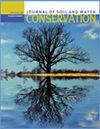Climate and pest interactions pose a cross-landscape management challenge to soil and water conservation
IF 2.6
4区 农林科学
Q2 ECOLOGY
引用次数: 1
Abstract
Climate change and biological invasions by plant pests (weeds), agriculture and forest insect pests (insects), and microbial pests (plant pathogens) are complex interactive components of global environmental change. The influence of pest distribution and prevalence across landscapes are challenging the conservation and sustainability of natural resources, agricultural production, native biological diversity, and the valuable ecosystem services they provide (Huenneke 1997; Vitousek 1997; Juroszek and von Tiedemann 2013; Ziska and Dukes 2014). Since 2000, numerous scientific studies indicate accelerating climate change is posing substantial risks to natural and managed systems in North America (IPPC 2022). Intensified droughts, large-scale wildfires, and increased demands for limited surface and groundwater water supplies in arid regions are threatening the sustainability of irrigated agriculture and contributing to economic losses (Stewart et al. 2020), while extreme rainfall events are contributing to severe riverine and urban flooding across the United States. Climate change affects crops, rangelands, forests, and natural areas directly through the immediate effects of temperature, precipitation, and atmospheric carbon dioxide (CO2) levels and thereby impacts production and management systems. These effects are amplified by climate-driven increases in weed, insect, and plant pathogen problems that further complicate related factors such as water, nutrient, and pest management (Walthall et al. 2013). Changing climates also alter physiological, ecological, and evolutionary processes that can support increased establishment, invasiveness, local spread, and geographic range changes of weeds, insects, and plant pathogens (Chidawanyika et al. 2019; Gallego-Tevár et al. 2019; Ziska et al. 2019) that have cascading effects on soil and water quality, and human livelihoods. Thus, a need exists for cross-habitat and landscape/watershed-scale perspectives to improve understanding of mechanisms underlying pest fitness and impacts within and across integrated systems.气候和病虫害的相互作用给水土保持带来了跨景观管理的挑战
气候变化和植物害虫(杂草)、农林害虫(昆虫)和微生物害虫(植物病原体)的生物入侵是全球环境变化的复杂相互作用的组成部分。有害生物分布和流行对自然资源、农业生产、本地生物多样性及其提供的宝贵生态系统服务的保护和可持续性构成挑战(Huenneke 1997;Vitousek 1997;Juroszek and von Tiedemann 2013;Ziska and Dukes 2014)。自2000年以来,许多科学研究表明,气候变化的加速正在对北美的自然和管理系统构成重大风险(IPPC 2022)。干旱加剧、大规模野火以及干旱地区对有限地表水和地下水供应的需求增加,正威胁着灌溉农业的可持续性,并造成经济损失(Stewart et al. 2020),而极端降雨事件正在导致美国各地严重的河流和城市洪水。气候变化通过温度、降水和大气二氧化碳水平的直接影响直接影响作物、牧场、森林和自然区域,从而影响生产和管理系统。这些影响被气候驱动的杂草、昆虫和植物病原体问题的增加所放大,这些问题进一步使水、养分和病虫害管理等相关因素复杂化(Walthall et al. 2013)。气候变化也会改变生理、生态和进化过程,从而支持杂草、昆虫和植物病原体的建立、入侵、局部传播和地理范围变化(Chidawanyika等人,2019;Gallego-Tevár等人,2019;Ziska et al. 2019),对土壤和水质以及人类生计产生级联效应。因此,有必要从跨生境和景观/流域尺度的角度来提高对综合系统内部和之间有害生物适应性和影响的机制的理解。
本文章由计算机程序翻译,如有差异,请以英文原文为准。
求助全文
约1分钟内获得全文
求助全文
来源期刊
CiteScore
4.10
自引率
2.60%
发文量
0
审稿时长
3.3 months
期刊介绍:
The Journal of Soil and Water Conservation (JSWC) is a multidisciplinary journal of natural resource conservation research, practice, policy, and perspectives. The journal has two sections: the A Section containing various departments and features, and the Research Section containing peer-reviewed research papers.

 求助内容:
求助内容: 应助结果提醒方式:
应助结果提醒方式:


